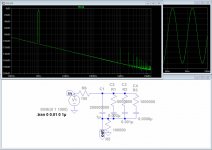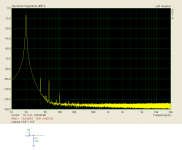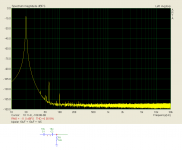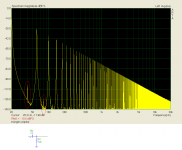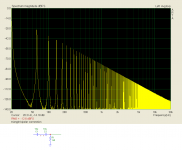Yes, LTSpice :-(LTspice. In the above, if compression is turned off, and the Maximum Timestep is set to 1u sec then the distortion goes away ...
...and me ;-(
Thanks, fas42
Attachments
Last edited:
For bi-polar -- sorry yes that cancels very well the non-linearity.
RNM
Yes, it cancels even harmonics (in this measurement the H2), in case there is more significant voltage across the capacitor terminals. Pls see the comparison unipolar x bipolar cap circuit test. At 200Hz, I had the same result for unipolar and bipolar. But, at 20Hz and component values used, we may see the difference.
Attachments
Last edited:
I know the 'theory' that C.Bateman used for his conclusion. Seems logical as Bateman test method and results.
Here is another 'theory' about DA. They were smart enough to put it under the heading of Theory.
Dielectric absorption - Wikipedia, the free encyclopedia
THx-RNMarsh
Hyster shift with voltage, perhaps?
THx-RNM
Ok my brain is cooked.
Here is another 'theory' about DA. They were smart enough to put it under the heading of Theory.
Dielectric absorption - Wikipedia, the free encyclopedia
THx-RNMarsh
Hyster shift with voltage, perhaps?
THx-RNM
Ok my brain is cooked.
yes it is.....
Check again.... Bateman .. copy of his page on DA comments. I take it that he doesnt see the descriptions listeners have given to electro with the tests he has done. That then is a fair statement. He hasnt tested it with asym waveforms which then begin to look like the comments I was hearing from listeners, then and now.
Attached are his words...... see where he says.... " The main difference I found which clearly does relate to dielectric absorption, is the magnitude of the second harmonic. This increases with applied voltage, especially so with electrolytic capacitors".
Which was my comparison. It interesting that we found same behaviour (2H) but from different tests.... mine finding from measuring the Vda. But I think the unique test I did rather than thd/fft with sine waves has benefit in finding out how it affects transient waveforms and that 'seems' to be heard as well.
View attachment 480155
Ok. yes, it is past my bed time.
THx-RNMarsh
Yes that's also the section I quoted. I think we agree, but, although I don't want to split hairs, it should be clear that although the 2nd harmonic level has a link to the DA, it's not DA itself that causes the 2nd.
Since the 2nd appears to be caused by some bias voltage dependent effects, I can imagine (but not proof) that DA which leads to changing bias voltage levels with time would effect the 2nd level. But I may be wrong.
Jan
Since the 2nd appears to be caused by some bias voltage dependent effects,
Jan
I agree, in electrolytic capacitors the 2nd appears when we have notable AC voltage across it, that said, the cap is also inversely polarized and it reflects in asymmetric distortion (the 2nd). Take two caps in series, bipolar connection, and the 2nd is canceled, in case we drive it from zero DC component generator.
Triangle wave test
The test with triangle wave nicely shows creation of even harmonics (they do not have to be there) in the signal with unipolar cap. With 2 caps in bipolar connection, no even harmonic products appear.
The test with triangle wave nicely shows creation of even harmonics (they do not have to be there) in the signal with unipolar cap. With 2 caps in bipolar connection, no even harmonic products appear.
Attachments
Lets go. (I'm not the king of the simulation, so if anything wrong, please tell-me):
The counterpart of dielectric absorption must be dielectric release, where the absorbed electrons are released after the electric field is removed. If absortion and release are not symmetrical, for example, if absortion were to ramp up quicker than release, there would be a non-linear mechanism to cause distortion. The same goes if the DA mechanism itself is not linear, that is, if DA is modulated by field strength. This might differ between different dielectric materials.
In other words, in this logic, it doesn't appear to be DA per se which is the culprit, but asymmetrical or non-linear absortion/release. This could explain why COG performs well, in spite of high DA. COG must be linear both in the sense that its DA is constant under different field strengths, and that absorption and release are symmetrical.
With a sim like Esperado did and the model it is based on, this release mechanism appears to be excluded. DA is not resistive, it is an energy storing mechanism.
Last edited:
I agree. I just took the model somewhere in line, and tried (surprised by the first result, but it was bed time, quick'n'dirty ;-).With a sim like this and the model it is based on, this release mechanism appears to be excluded. DA is not resistive, it is an energy storing mechanism.
In fact, i don't understand the interest, for us, of this all discussion about DA or other causes. Whatever the origin of the distortions, what matters is what kind of Caps we can chose in each situation to get the best available results, no ?
This said, my first mistake has an interest. No distortion in the second simulation, while we can measure some in real life. That means the model is not accurate, i think.
Last edited:
The test with triangle wave nicely shows creation of even harmonics (they do not have to be there) in the signal with unipolar cap. With 2 caps in bipolar connection, no even harmonic products appear.
Nice Pavel!
Jan
That means the model is not accurate, i think.
That might very well be true. But do we have something better? Could we model asymmetric absorbtion/release with parallel resistor/diode chains to simulate asymmetric charge/discharge of the subsequent RC in the model?
Jan
In other words, you mean, it IS the DA, but this DA is not linear ?In other words, in this logic, it doesn't appear to be DA per se which is the culprit, but asymmetrical or non-linear absortion/release.
I think we may need a new model for an electrolytic capacitor, that would reflect behavior of its polar dielectric and will be different for positive and negative signal across the capacitor. A kind of diode included?
I think we may need a new model for an electrolytic capacitor, that would reflect behavior of its polar dielectric and will be different for positive and negative signal across the capacitor. A kind of diode included?
Yes that is what I said above ;-)
jan
In other words, you mean, it IS the DA, but this DA is not linear ?
No. Look at Pavel's measurements again.
I think we may need a new model for an electrolytic capacitor, that would reflect behavior of its polar dielectric and will be different for positive and negative signal across the capacitor. A kind of diode included?
Think about the electrochemistry at each electrode. The double layer is not symmetric.
So the reasoning appears to be:RNMarsh said:Any non-linear distortion in a polar (or film), appears to me to be coming from the dielectric material. DA is a sensitive test when Not using symmetrical waveforms. It can be used to select caps based on DA. Non-linear distortion of polar caps is very likely due to DA. IMO. Its just a smoking gun sort of thing to me.
Cap nonlinearity is caused by the dielectric.
DA is caused by the dielectric.
Therefore DA causes a part of cap nonlinearity.
Minor snags with this 'argument':
It contains a logical fallacy.
DA can be modelled quite accurately using linear things only.
DA is poorly correlated with other known measured dielectric nonlinearities.
Time domain waveform distortions are trivially produced in a linear fashion by using filters; DA is expected to produce a mild filtering effect.
I hope Dick never has to serve on a jury!
No. If this were the case then DA would need to be modelled with a ladder of CR with diodes in it too. The diodes are not needed.vacuphile said:In other words, in this logic, it doesn't appear to be DA per se which is the culprit, but asymmetrical or non-linear absortion/release.
To get 2nd you need some asymmetry. Most non-linear dielectrics (if not deliberately poled) have a symmetric response about zero electric field. Hence you need asymmetric construction (unlikely in a film cap, but inherent in an electrolytic) or a bias voltage or something equivalent - which could be caused by DA acting on an asymmetric signal. So at most all DA can do is provide the conditions for a dielectric nonlinearity to produce some 2nd where without DA it would only produce 3rd and other odds. In most circuits this effect of DA would be swamped by the effect of any DC bias on the cap.
Think about the electrochemistry at each electrode. The double layer is not symmetric.
Yes, and that's your field, your knowledge that may help.
I have seen mylar capacitors operating at elevated temperature and relatively high voltage (~50V for 63V parts) during extended periods (~20yrs, 24/7) become polarized: the dielectric had acquired electret properties.To get 2nd you need some asymmetry. Most non-linear dielectrics (if not deliberately poled) have a symmetric response about zero electric field. Hence you need asymmetric construction (unlikely in a film cap, but inherent in an electrolytic) or a bias voltage or something equivalent - which could be caused by DA acting on an asymmetric signal. So at most all DA can do is provide the conditions for a dielectric nonlinearity to produce some 2nd where without DA it would only produce 3rd and other odds. In most circuits this effect of DA would be swamped by the effect of any DC bias on the cap.
I was alerted, because when tested with a sinewave, they acted as a transducer, or electrostatic speaker, quite effectively in fact given the very non-optimal geometry for this job.
The sound emitted was at the fundamental, not the double frequency, which means they probably generated 2nd H due to the bias shift (not tested though).
Of course, this is a very extreme case of "soaking"
I hope Dick never has to serve on a jury!
(you are assuming he has not already)
So the reasoning appears to be:
Doug, one of your points is that DA can be accurately modelled by RC's, and thus cannot cause nonlinearities. But we don't know that, do we? When we measure DA by charging/discharging it follows nicely the model. But we are not looking at any form of nonlinearity so the model is not tested for that.
The model is only tested and found valid to 'model' charge/discharge, because that's where we use it for.
Maybe we need another model for another aspect of DA that DOES cause nonlinearity. Not saying it does, just trying to point out what I see as a limit to the existing DA model validity.
jan
- Status
- Not open for further replies.
- Home
- Member Areas
- The Lounge
- John Curl's Blowtorch preamplifier part II
